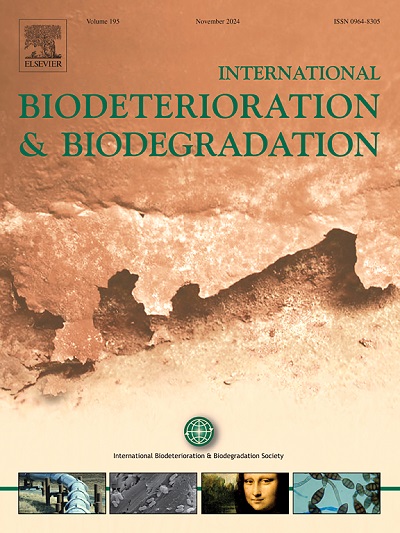有机负荷率对连续流反应器好氧颗粒污泥培养及稳定性的影响
IF 4.1
2区 环境科学与生态学
Q2 BIOTECHNOLOGY & APPLIED MICROBIOLOGY
International Biodeterioration & Biodegradation
Pub Date : 2025-02-01
DOI:10.1016/j.ibiod.2025.106016
引用次数: 0
摘要
为研究连续流系统中有机负荷率(OLR)对好氧颗粒污泥(AGS)形成的影响,综合分析了水力停留时间(HRT)和进水化学需氧量(COD)调节的有机负荷率(OLR)对污染物去除率、造粒效率和微生物群落的影响。结果表明,通过降低HRT来增加OLR会导致丝状污泥膨胀和生物量损失。相反,通过调节进水COD,逐步提高OLR至0.19 kg·(kg·d)−1,第60天造粒效率由3.00%提高至28.40%,平均粒径为193.60 μm。而过量的OLR会促使丝状菌利用氧池中剩余的COD。有机物利用途径分析表明,当进水COD为350 mg L−1时,厌氧期COD的利用率由聚磷酸盐生物(PAOs)、聚糖原生物(GAOs)和吸附作用(44.85±2.50%)提高。PAOs和GAOs的相对丰度分别提高到4.14%和3.18%。这是造成肉芽肿的主要原因。此外,提出了在连续流系统中提高造粒的策略:增加厌氧池的体积或引入间歇混合,以使更多的进水有机物在进入氧池之前被更大的生物质利用。本文章由计算机程序翻译,如有差异,请以英文原文为准。

The impact of organic loading rate on the cultivation and stability of aerobic granular sludge in continuous flow reactor
To investigate how organic loading rate (OLR) affects the formation of aerobic granular sludge (AGS) in continuous flow system, the effect of OLR adjusted by hydraulic retention time (HRT) and influent chemical oxygen demand (COD) on pollutant removal, granulation efficiency and microbial community were comprehensively analyzed. The results showed that increasing OLR by decreasing HRT led to significant filamentous sludge bulking and biomass loss. Conversely, gradually increasing the OLR to 0.19 kg·(kg·d)−1 by adjusting influent COD improved the granulation efficiency from 3.00% to 28.40% with the average particle size of 193.60 μm at the 60th day. However, excessive OLR would promote filamentous bacteria to use the residual COD in the oxic tank. Organic matter utilization path analysis showed that the COD utilization enhanced by phosphate accumulating organisms (PAOs), glycogen accumulating organisms (GAOs) and adsorption (44.85 ± 2.50%) during anaerobic phase when influent COD was 350 mg L−1. And the relative abundance of PAOs and GAOs increased to 4.14% and 3.18%, respectively. This was the main cause of granulation. Furthermore, strategies to enhance granulation in continuous flow systems were proposed: Increase the volume of anaerobic tank or introduce intermittent mixing to keep more influent organics is used by bigger biomass before entering the oxic tank.
求助全文
通过发布文献求助,成功后即可免费获取论文全文。
去求助
来源期刊
CiteScore
9.60
自引率
10.40%
发文量
107
审稿时长
21 days
期刊介绍:
International Biodeterioration and Biodegradation publishes original research papers and reviews on the biological causes of deterioration or degradation.

 求助内容:
求助内容: 应助结果提醒方式:
应助结果提醒方式:


